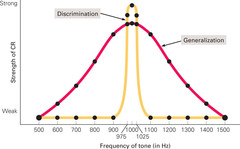classical conditioning
acquiring a new response (the CR) to a previously neutral stimulus (the CS) that reliably signals the arrival of an US
classical conditioning
learning that one stimulus signals the arrival of another stimulus
stimulus
any sight, sound, smell, taste, or body sensation that a human or animal can perceive
classical conditioning is sometimes referred to as ____
Pavlovian conditioning
• because Pavlov was the first researcher to study this type of learning systematically
reflex
a stimulus-response pair in which the stimulus (the US) automatically elicits the response (the UR)
*Four Elements of Classical Conditioning*
UCS, UCR, CS, and CR
neutral stimulus
a stimulus that does not naturally elicit the to-be-conditioned response
unconditioned response (UCR)
the response in a reflex that is automatically elicited by the unconditioned stimulus
unconditioned stimulus (UCS)
the stimulus in a reflex that automatically elicits an unconditioned response
conditioned stimulus (CS)
the stimulus that comes to elicit a new response (the conditioned response) in classical conditioning
conditioned response (CR)
the response that is elicited by the conditioned stimulus in classical conditioning
Pavlovs's Research
Pavlov began with a neutral stimulus (a tone) in his conditioning research on dogs. Before conditioning, his dogs did not automatically salivate to these stimuli. They had to learn (be conditioned) to do this. To achieve such conditioning, the neutral stimulus (for example, a tone) is presented just before the UCS (the food). Once the conditioning occurs (signaled in Pavlov's research by the dog salivating to the sound of the tone before the meat powder is put into its mouth), the neutral stimulus is referred to as the conditioned stimulus (CS).
This previously neutral stimulus (the tone) comes to elicit a new response (salivating) after repeated pairings with the unconditioned stimulus (meat powder in the dog's mouth). The learned response (salivating) to the conditioned stimulus (the tone) is called the conditioned response (CR). The conditioned response (salivating) is a preparatory response for the impending UCS (meat powder in the dog's mouth).
For classical condition, a neutral stimulus is presented just before the UCS, what does "Just before" mean?
this can mean a few seconds, but the optimal time interval between the onsets of the two stimuli is usually very brief, only a half-second to a full second *because the conditioning involves learning that this stimulus is a reliable predictor for the arrival of the UCS*
presenting the UCS before the CS (called backward conditioning) or presenting the UCS and CS at the same time (called simultaneous conditioning) typically leads to no conditioning or poor conditioning because _____
the CS in these two cases would not be a good predictor of the UCS.
The *CS has to clearly predict the UCS by being presented first or conditioning usually will not occur*
What is an example of an exception in which classical conditioning can be obtained without a close temporal pairing of the CS and UCS and in only a small number of trials?
taste aversion
What are the two ways to present the CS first?
• delayed conditioning
• trace conditioning
delayed conditioning
a classical conditioning procedure in which the CS comes before the US and remains present until after the UCS is presented so that the two stimuli occur together.
• the CS is "delayed" until after the UCS starts
i.e. in Pavlov's experiment the tone is turned on and left on until the meat powder is put in the dog's mouth
trace conditioning
a classical conditioning procedure in which the CS comes before the UCS but is removed before the UCS is presented so that the two stimuli do not occur together.
classical conditioning procedure
• there is a period of time between turning off the CS and the onset of the UCS (called the trace interval), when neither stimulus is present
For the association between stimuli to be learned, the animal or human (dog in Pavlov's case) must maintain a "memory trace" of the CS (the tone) to pair with the later-occurring UCS (the meat powder). This is why it is called trace conditioning
Delayed conditioning is the most effective procedure for classical conditioning, but trace conditioning can be almost as effective if the trace interval between stimuli is very short (Powell, Symbaluk, & MacDonald, 2002).
It also appears that for trace conditioning, processing by both the cerebellum and hippocampus is essential for successful conditioning whereas for delayed conditioning, only processing by the cerebellum is necessary. In trace conditioning, processing by the hippocampus is necessary to establish a memory trace of the CS so that it can be associated with the UCS following the trace interval. In addition, it appears that delayed conditioning can be accomplished without conscious awareness of the temporal relationship between the CS and UCS, but trace conditioning cannot
*The Elements of Classical Conditioning*
In classical conditioning, you start with a reflex—an unconditioned stimulus (UCS) that automatically elicits an unconditioned response (UCR). To condition a new response to a neutral stimulus, the neutral stimulus is presented just before the unconditioned stimulus.
After several pairings, the neutral stimulus elicits a new response called the conditioned response (CR). The neutral stimulus is now referred to as the conditioned stimulus (CS).
Little Albert Study by John B. Watson
To examine the possible role of such conditioning in human emotional responses such as fear
As a neutral stimulus, the researchers used a white laboratory rat.
Albert was not afraid of the rat. In fact, when he saw the rat before the conditioning, he moved toward it and touched it. What was the reflex that Watson and Rayner used? While Albert was looking at the white rat, Watson quietly sneaked behind him with an iron bar and a hammer and clanged them together. Albert's reflexive response, the UCR, was the fear-avoidance response (crying and trying to crawl away) to this unexpected loud noise, the UCS. Watson and Rayner paired the sight of the white rat (the neutral stimulus that became the CS) with the unexpected loud noise (the UCS) several times until the sight of the white rat started eliciting the fear-avoidance response (crying and trying to crawl away from the rat).
He also generalized this conditioned fear response to a rabbit.
classical conditioning is not only involved in conditioning negative emotional responses such as fear, but can also be used to develop positive emotional responses to stimuli
classical conditioning is used in advertising in order to condition positive attitudes and feelings toward products
John Watson pioneered this type of advertising when he worked as a psychology consultant for the J. Walter Thompson advertising agency
learning processes involving the CR
- acquisition
- extinction
- spontaneous recovery
- stimulus generalization
- discrimination.
acquisition
(in classical conditioning) acquiring a new response (the conditioned response) to the conditioned stimulus
extinction
(in classical conditioning) the diminishing of the conditioned response when the unconditioned stimulus no longer follows the conditioned stimulus
spontaneous recovery
(in classical conditioning) a partial recovery in strength of the conditioned response following a break during extinction training and indicates that the CR may still be available in a weakened or inhibited form
*Acquisition, Extinction, and Spontaneous*
Recovery Panel (a) depicts the acquisition of the CR.
Note that during acquisition, the UCS follows the CS on each trial. Acquisition of the CR is reflected in the increase in its strength across conditioning trials. Extinction is depicted in panel (b). On extinction trials, the UCS never follows the CS. This process is reflected in the decrease of the strength of the CR across extinction trials. Note, however, that when a break is taken during extinction training, there is a temporary partial recovery in strength of the CR following the break, depicted in panel (c).
This partial recovery is called spontaneous recovery. The amount of recovery lessens as extinction training continues.
stimulus generalization
stimuli similar to the CS elicit the CR. The more similar the stimulus is to the CS, the stronger the response will be
• generalization is an adaptive process.
stimulus discrimination
is the elicitation of the CR only by the CS or only by a small set of highly similar stimuli that includes the CS
• in the dog bite example, this would be learning only to fear potentially dangerous dogs
Why can generalization and discrimination can be thought of as opposites?
because generalization is the broadening of the conditioned response to other stimuli, whereas discrimination is the narrowing of the response to only the stimulus followed by the UCS and those stimuli so similar to this stimulus that they cannot be discriminated from it
Classical conditioning would not be a very useful type of learning if it only allowed us to learn relationships between specific stimuli. If a dog bites you, isn't it more adaptive to generalize the fear-avoidance response to other dogs (especially dogs similar to the one that bit you)?
*Stimulus Generalization and Discrimination*
These are idealized stimulus generalization and discrimination results following classical conditioning of the salivary response (CR) in dogs to a tone of 1,000 Hz (CS). The strength of the CR to generalization test stimuli (all tones except the 1,000 Hz tone) decreases as the similarity of the test stimulus to the original CS decreases.
These generalization responses, however, can be extinguished through discrimination training in which the UCS (food) only follows the 1,000 Hz tone. The CR to each of the other tones will be extinguished except for the tones so similar to the 1,000 Hz tone (975 Hz and 1,025 Hz) that the dog does not perceive them as different.
Little Albert study by Watson
The generalization stimuli did not vary symmetrically around the white rat, but the same pattern of generalization results were observed. As the generalization test stimuli became less similar to the CS (the white rat), the strength of the CR (the fear-avoidance response) decreased. The response to the other animals and the coat was stronger than the responses to the mask and hair.
Similarly, the response to the white cotton was even less, and it was nonexistent for the toy blocks.
*discrimination training*
What do you think happens? What normally happens to the CR when the UCS is removed in classical conditioning? It is extinguished. This is what *discrimination training* does; it diminishes the responding to the other stimuli.
The animal has learned only to salivate to the 1,000 Hz tone and tones very similar to it (975 Hz and 1,025 Hz). Why does the animal salivate at all to any stimulus other than the 1,000 Hz tone? It wouldn't if it had perfect pitch perception and could discriminate all frequencies, but it can't. Thus, the animal salivates to this narrow range of frequencies because it has difficulty differentiating them.
*General Learning Processes in Classical Conditioning*
Why is Watson and Rayner's Little Albert study an example of the delayed conditioning procedure and not the trace conditioning procedure?
The Little Albert study is an example of using the delayed classical conditioning procedure because the CS (the white rat) was presented before the UCS (the loud, unexpected noise) and remained there until the UCS was presented. If the white rat had been taken away before the unexpected loud noise, then the study would have been an example of using the trace conditioning procedure.
Which other general learning process is used in discrimination training?
*Extinction* because the responses to all stimuli except the original CS are diminished because the UCS does not follow any of them. However, if a stimulus cannot be discriminated from the CS, the response to it is not extinguished.




